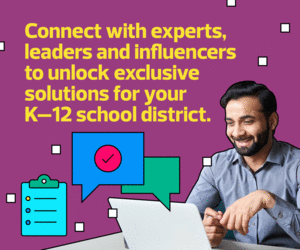1. Curriculum with Esports Skills and Lessons
When district leaders and teachers are preparing to launch a new instructional program, they consider the availability and access they have to quality curriculum. For an esports program to be successful, it’s important to think beyond the game to the ways you will introduce the tenets of esports into your instruction. This can be through deliberate instruction around esports-specific lessons and skills or by weaving esports into your existing courses through lessons on digital citizenship and other relevant topics you’re already covering.
Consider the following:
- Are we building an actual esports curriculum and specific courses that will support our program?
- How can we weave this in where we are teaching digital citizenship, media literacy or other relevant lessons?
- Which of our existing career technical education, magnet or innovative programs have a curriculum that would support this work?
WATCH NOW: Experts share how to create a successful K–12 esports program.
2. Career Pathways and Opportunities for Team Members
For every professional sports team, there might be a few dozen players on the roster, but there are hundreds — even thousands — of people working behind the scenes to support that team. The same is true for professional esports organizations.
As you consider your plans for an esports program, map out the different pathways your district offers for students in CTE. Then take a moment to consider all the facets of a successful esports program that can be supported by the students in marketing, broadcasting, graphic design, entrepreneurship, IT and more.
Consider the following:
- Are we being intentional about the students on pathways beyond gaming who can be involved in our program?
- Are we making clear to students the myriad career pathways that stem from esports and providing access to opportunities?
- How do we plan to develop skills beyond the games and healthy digital habits for our students?
3. Scope and Sequence at the District Level
Many districts start an esports program with an idea for a club team at the local high school. Mirroring traditional sports, which introduce necessary skills early and work up to competition, scholastic esports can also benefit from early introduction. What is the overall plan in your district for building out a sustainable program that not only creates competitive gamers but also helps them develop as part of a successful team? Consider how you might introduce esports to younger students through programs like Minecraft: Education Edition or familiar console games.
Consider the following:
- Does this fit within an overall plan for esports in the district, or are we thinking about this as a random act of gaming?
- How are we going to scaffold our program (for example: Minecraft: Education Edition at the elementary level, Rocket League and Super Smash Bros. at the middle school level, and Rocket League and League of Legends at the high school level)?
- What are our pathways to success? Will there be a practice squad, junior varsity and varsity teams?
4. Coach and Player Development Over Time
Many esports programs are started by an enthusiastic teacher or staff member and a group of students who are passionate about gaming. This club approach is great for engaging students in an activity, but as with traditional sports, coaches need to develop their players’ skills through deliberate practice. These coaches also attend conferences and train to hone their own skills over time.
RELATED: Learn how to create memorable online professional development for educators.
Because esports programs are usually started by one staff member, the team risks disbanding if that coach decides to move on to a new role or retire. Involving a small group of staff members in different aspects of the team and taking advantage of organizations (such as the North America Scholastic Esports Federation, or NASEF) that provide scholastic esports coach development will be vital to creating a program that outlasts one primary leader.
Consider the following:
- What are our plans to address the growth of our program over time by developing our coaches?
- How might we build capacity in our leadership and staff to make sure that our program isn’t dependent on one enthusiastic person?
- Are we using existing (and amazing) resources like those provided by NASEF to build systems or support for our coaches and students?
5. Invest in the Program’s Sustainability
If we’ve developed the skills of players and staff, we’ve made progress toward a sustainable program, but there are also monetary and partnership considerations. To build a program that is sustainable and competitive, there are investments that must be made in equipment, furniture and other resources. In the long term, partnering with local businesses that have a vested interest in getting students ready for the workforce — especially in “beyond the game” skills — will create a support system that lasts.
Consider the following:
- We may be able to fund our initial push, but how do we ensure continued funding for the future of the program?
- Can we establish community and business partnerships with organizations that might benefit from students building skills through a sustained, successful esports program?
- Where else might we look for funding and continued support for our program and its players?











